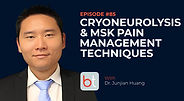BackTable / MSK / Podcast / Episode #62
Exploring Intradiscal PRP for Back Pain Relief
with Dr. Guilherme Ferreira Dos Santos
How are orthobiologics transforming the back pain treatment algorithm? In this episode of BackTable MSK, host Jacob Fleming is joined by Dr. Guilherme Ferreira Dos Santos to discuss the management of lumbar pain and the role of platelet-rich plasma (PRP) injections. Dr. Santos is trained in Physical Medicine & Rehabilitation as well as Interventional Pain Medicine, and currently practices at the Hospital Clinic of Barcelona.
Be part of the conversation. Put your sponsored messaging on this episode. Learn how.

BackTable, LLC (Producer). (2024, October 29). Ep. 62 – Exploring Intradiscal PRP for Back Pain Relief [Audio podcast]. Retrieved from https://www.backtable.com
Stay Up To Date
Follow:
Subscribe:
Sign Up:
Podcast Contributors
Synopsis
Dr. Santos gives an overview of discogenic pain. Each patient case is unique, as pain can be caused by single level or multilevel disease, pure disc disease, or additional facet joint disease. Additionally, discogenic pain can affect young, active patients and typically worsens with spinal flexion. They discuss the Pfirrmann system for intervertebral disc degeneration, medial branch blocks to identify posterior column pain, the risk of disc degeneration after discography, and the rise of orthobiologic treatments such as intradiscal and facet joint PRP injections. Dr. Santos highlights important steps for PRP preparation and techniques for injection. He also gives advice for counseling patients about the timeline to pain relief, longevity of treatment effects, and options for refractory pain. Finally, Dr. Santos encourages the audience to stay tuned for the upcoming RESPINE multicenter trial results.
Timestamps
00:00 - Introduction
02:18 - Dr. Santos’ Multicultural Experiences
08:58 - Challenges in Diagnosing and Treating Discogenic Pain
20:26 - Role of Intradiscal and Facet Joint PRP Injections
30:16 - PRP Preparation and Dosing
34:52 - Technical Aspects of Disc Treatments
42:54 - Patient Counseling
56:58 - Future Directions in Regenerative Medicine
Resources
RESPINE Trial:
https://ecrin.org/clinical-trials/respine
Lumbar Intradiskal Platelet-Rich Plasma (PRP) Injections: A Prospective, Double-Blind, Randomized Controlled Study (Tuakli-Wosornu, 2016):
https://pubmed.ncbi.nlm.nih.gov/26314234/
Clinical outcomes following intradiscal injections of higher-concentration platelet-rich plasma in patients with chronic lumbar discogenic pain (Lutz, 2022):
https://pubmed.ncbi.nlm.nih.gov/35344055/
Transcript Preview
[Dr. Guilherme Santos]:
To your point, I think a lot of the lack of awareness has to do with what treatments are out there and available for patients from a specific disease. You know 20 years ago, we all focused on what we call posterior column syndrome, so facetogenic back pain, right? Why? Mostly because we could to a certain degree address and treat facetogenic back pain, but 20, 25 years ago, there was not a lot we could do for anterior column syndromes, meaning discogenic, vertebrogenic, or disco-vertebrogenic pain.
I believe that now with, I wouldn't want to say that the beginning of, but the rising of orthobiological treatments being applied in pain medicine, specifically in the spine, everyone suddenly becomes more aware of anterior column syndromes because now we have something that we can offer patients that offers a potential line of treatment. Obviously, it won't work for everyone, it's not a miracle drug, but it's derived from your own body, your own peripheral blood. If you do the procedure and it doesn't work, at least under normal circumstances, you won't face any major complications or side effects from the procedure itself except for the small but non-residual risk of infection and post-procedural flare-up of pain for a few days and all of that stuff.
Having said this, most, I'd say, up-to-date literature suggests that about 35 to 40, 45% of cases of axial non-radicular back pain, low back pain, is generated from discogenic sources. It comes from the inflammation and late-stage degeneration of the lumbar intervertebral discs. What I say to my patients when they come in with axial low back pain, no red flags on physical examination, and before we start ordering any sort of MRIs, CTs, whatever it may be, if you present with these symptoms and your physical exam is positive for this and this, you're probably, like most of my other patients, have an about 50% chance that your pain is coming from one of your discs, and your discs may be degenerating.
The Materials available on BackTable are for informational and educational purposes only and are not a substitute for the professional judgment of a healthcare professional in diagnosing and treating patients. The opinions expressed by participants of the BackTable Podcast belong solely to the participants, and do not necessarily reflect the views of BackTable.













